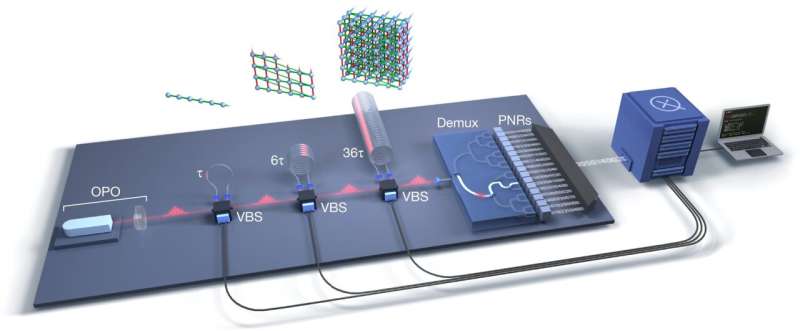June 2, 2022 report
Quantum machine Borealis achieves computational advantage using programmable photonic sensor

A team of researchers from Xanadu in Canada and the National Institutes of Standards and Technology, in the U.S., is claiming that their quantum computer, Borealis, has achieved computational advantage in taking on the boson sampling challenge. In their paper published in the journal Nature, the group describes their computer and how well it performed when tackling the challenge. Daniel Jost Brod, with the Federal Fluminense University, in Brazil, has published a News & Views piece in the same journal issue outlining the short history of quantum computing and the work done by the team on this new effort.
As work continues toward a truly usable quantum computing machine, research groups add more power to the devices they are working on and then subject them to computational advantage tests. Such tests are meant to show that a given device is able to process a problem that would take conventional computers so long to run that doing so would be impractical.
In this new effort, the researchers took on the boson sampling challenge using a photonic machine that uses photons to represent qubits. Technically called the Gaussian boson sampling challenge, it involves preparing states of light and directing them through a network of beam splitters and then counting how many of the photons arrive at a detector. The best modern computers get bogged down quickly when attempting the challenge, whereas theory has suggested a quantum computer should shine. Prior efforts to take on the challenge have involved the use of 76 to 113 photons. The machine built by the team on this new effort was able to access up to 219 photons, while it averaged 125—a significant leap forward.
In running the challenge, the team found that Borealis was able to perform the specified task in 36 microseconds. The researchers calculated that it would have taken the best traditional computer approximately 9,000 years to accomplish the same task. This difference, the researchers claim, shows computational advantage. The researchers took their work one step further by testing the output given by Borealis and showed that it could not be spoofed, evidence that the answers it gave were correct.
More information: Lars S. Madsen et al, Quantum computational advantage with a programmable photonic processor, Nature (2022). DOI: 10.1038/s41586-022-04725-x
Daniel Jost Brod, Loops simplify a set-up to boost quantum computational advantage, Nature (2022). DOI: 10.1038/d41586-022-01402-x
Journal information: Nature
© 2022 Science X Network



















